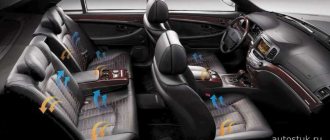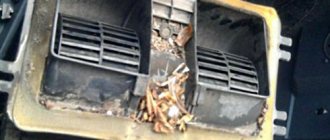The thin metal of a car body or truck cab instantly reacts to fluctuations in atmospheric temperature. In summer, the temperature in the cabin can rise to 40 - 50 degrees. In winter, the temperature in the cabin or cabin differs from the outside frost by 2-3 degrees. Drivers and passengers of vehicles escape from summer overheating by turning on the air conditioner or opening the windows. In winter, only the car's heating system can ensure a normal temperature in the cabin. In the climatic conditions of Russia, normal operation of a car heater is relevant for two thirds of the year.
Operating principle of a car heater
In the history of the car, there were even such types of interior heating as compact coal and wood stoves, and gas lamps. Later, exhaust gases were used for heating. Automakers have practically abandoned water-based interior heating, which was used in some models of passenger buses. Heated water circulating through pipelines under the seats and on the walls of the cabin quickly cooled, and the heating system had low efficiency.
Modern heating systems primarily use engine coolant to heat the interior using heated and filtered atmospheric air. A fan is used for forced air intake. The air is heated by the heat transfer of a running automobile engine, the intensity of its supply is regulated manually or automatically.
A normally functioning car heater, which drivers simply call a “stove,” heats the air in the cabin to 20–25 degrees Celsius in winter. An additional function of a car heater is to warm up foggy or frozen car windows and defrost frozen windshield wipers.
Features of stove operation and repair
Since the main element of any heating unit is an electric motor, we suggest that you familiarize yourself with the process of replacing it using the example of a VAZ 2110 car.
How to change an electric motor with your own hands:
- First of all, you should remove the wiper blades, then dismantle the frill.
- The frill itself should be moved to the side, and then, using a Phillips-head screwdriver, unscrew the three screws.
- Having done this, you can disconnect the wires from the existing electric motor.
- Now all you have to do is remove the old gear motor from its seat and replace it with a new device. Further assembly is carried out in reverse order.
As for the main operating features, in order to prevent damage to the heater, we recommend following the following rules:
- If your vehicle is equipped with air conditioning, it is best to turn it on in wet weather, since the air conditioner allows you to remove moisture from the interior.
- Never obstruct the air blowers through which air flows into the cabin, in particular, we are talking about the nozzles that are located in the lower part and are used to blow the legs.
- During the cold season, vehicle windows must be thoroughly cleaned of moisture and dirt.
- In addition, during frosty periods, experts recommend using two adjustment positions for the stove. If you need to quickly dry the windshield, then the windshield blower is turned on. And when you start moving, it is best to activate the foot airflow mode.
Design of standard heating systems
A stationary heating system for a car with an internal combustion engine (diesel or gasoline) uses the operating heating of the engine as a heat source.
In most heating systems, the air intake fan and heat exchanger (heater radiator) are installed in front of the engine compartment partition. The heat exchanger is connected to the cooling system of the automobile engine through outlet and inlet pipelines. Atmospheric air forced by the fan heats up when passing through the radiator honeycombs. After this, the heated air passes through the cabin filter and is supplied through pipelines to the cabin ventilation deflectors.
Engine cooling system
For various car models, deflectors are located in the center console, under the windshield, and can exit at the feet of the rear passengers. The usual temperature of a running engine of 90 degrees ensures that the air supplied to the cabin is heated to 30 - 35 degrees.
An important quality of the heating system is the regulation of the supply of warm air. The air supply force is adjusted by turning the knob or pressing the button with the fan icon (for air conditioning systems).
Manual adjustments of the air direction to the sides using the deflector flaps are very approximate. Climate control adjustments work much more accurately. After the driver sets the desired temperature in the on-board computer, the climate control control unit automatically adjusts the opening or closing position of the dampers using temperature sensors through servos.
Construction of a modern interior heater with air conditioning
Heating systems of many car models can use direct and recirculation modes for supplying heated air. The recirculation mode operates when the main air intake damper is closed. In this position, the heating system intake fan uses only the volume of air from the passenger compartment. At the same time, the air temperature increases, and the unpleasant odors of road dust and car exhaust disappear from the cabin.
The recirculation mode works most effectively in automatic climate control units. The climate control unit, based on the readings of gas analyzers, automatically turns on the recirculation mode when harmful substances are detected in the atmospheric air. The recirculation mode is also automatically switched off if the percentage of carbon dioxide in the cabin from the breath of passengers increases.
Possible faults
To diagnose a heater, you just need to turn on the unit and evaluate whether it is working efficiently or not. If operating efficiency is reduced or traces of coolant leaks appear in the car interior, then the unit requires more thorough diagnostics and repair.
What malfunctions are typical for the heater:
- Failure of the control module located on the dashboard. There may be mechanical damage to the control elements, as a result of which the heater cannot operate in different modes.
- The interior heater radiator has failed. When this unit breaks down, as a rule, it begins to leak, which contributes to the formation of a puddle in the car interior, under the front mats (usually under the passenger mat).
- The electric or mechanical heater faucet is leaking. This malfunction also contributes to the leakage of working fluid; the problem is solved by replacing the part.
- Failure of the electric motor. If the motor breaks for some reason, then, as you can understand, the operation of the device will be impossible. As a rule, the electric motor cannot be repaired, so it must be replaced as an assembly.
- Failure of the temperature controller, which is usually located in the cabin. This sensor is necessary for automatic activation of the heating device.
- Another reason why the unit will not work efficiently is a coolant leak. If the leak is not related to a broken radiator or faucet, then most likely the cause is worn hoses. Worn pipes should be replaced before adding antifreeze.
Photo gallery “Main faults”
Autonomous interior heaters
In addition to heating functions when the engine is running, in some cases it is necessary to provide pre-heating of the interior and warming up the engine. For this purpose, autonomous heaters and pre-heaters are installed on trucks and passenger cars. Among the high-quality manufacturers of autonomous heaters, the brands Webasto, Eberspacher, and the Russian brand “Planar” stand out.
Despite the mistrust of car owners in autonomous heaters, the benefits of such a device are obvious. When using it, there is no need to idle warm up the engine, which brings significant fuel savings. Using the remote activation of the autonomous heater, the driver gets behind the wheel into a warm interior with clean windows and wipers ready for work. Engine wear is reduced by eliminating cold starts with cooled oil.
For trucks in a number of European Union countries, autonomous heaters are legally recognized as mandatory equipment. Without them, long-haul truck drivers are prohibited from spending the night or resting in cabins at roadside stops and cargo parking lots. In this way, European authorities are fighting additional emissions of harmful exhaust from running engines into the atmosphere and reducing noise levels.
Most often, autonomous heaters operate on the main fuel of the engine. Therefore, their models are divided into gasoline, diesel, and gas. These heaters are similar in design.
All models, assembled in a separate compact case, use:
- sealed combustion chamber;
- fuel supply pipeline from the standard fuel tank;
- air blower;
- circulation pump;
- heat exchanger;
- spark plug or glow plug;
- overheat sensor;
- Control block.
Gasoline air heaters for passenger cars are more compact. With a power reaching 46 kW, they can be installed under the hood of a car. Diesel heaters and liquid engine pre-heaters for trucks are distinguished by greater power (up to 82 kW) and size.
The electric autonomous heater does not use automobile fuel and operates on the principle of a fan heater. The heating device is often called a hair dryer. The sealed ceramic housing contains intake and exhaust fans, an electric coil or ceramic elements that heat the air. An autonomous electric hair dryer, powered by a battery through a cigarette lighter, does not have enough power to fully heat the interior, so it is used as an additional heating source.
A stationary electric heater of a similar design, powered by the on-board electrical network, has become the basis of the heating system of electric vehicles. It is this that provides thermal comfort in the cabin, built into the climate system unit and supplemented by heating of all seats of the car.
How does engine preheating work?
Warming up of the engine is carried out by burning gasoline or diesel fuel from the standard fuel tank of the vehicle in the combustion chamber of the device. The equipment is mounted in the engine compartment and connected to the engine liquid cooling system.
Using a pump, fuel is pumped into the combustion chamber. In the combustion chamber, the fuel is ignited by a spark plug. The heated boiler releases heat to the coolant through a pump pumped into the device, which circulates the coolant throughout the engine cooling system.
The parameters of the sensors and timer are set from the control panel (the start and shutdown times of the equipment, temperature are set). If the car has a navigation system, it is possible to start the equipment via a mobile phone.
When the coolant warms up, you can use the remote control to turn on the standard heater fan, which will heat the interior when the driver arrives. The liquid system consumes about 0.5 liters of fuel per hour.
Disadvantage of the system
- When the heating system operates, energy consumption increases, which can lead to battery discharge.
- High price
pros
- Reliable engine starting at any ambient temperature.
- The salon is heated.
- The system consumes less fuel compared to warming up at idle speed.
- Low noise level.
- Versatility (can be used on all types of internal combustion engines with a water cooling system).
Automotive heater: from hot stones to climate control
One day, a friend of mine who was reading Tom Bower’s book “Formula 1 - the story of the main auto race in the world and its leader Bernie Ecclestone” said: “The book is stupid, there is an episode in which Bernie sold a car without a stove. Couldn’t they come up with a more plausible story?” Apparently, it was about the following paragraph:
“One of the Whitehouse employees named Peter Rix once asked him over a glass of beer:
— Do you have a good used MG?
“Yes,” Ecclestone replied. - Bright red.
- Is there a stove there? - asked Ricks, since the stove was installed separately in the car.
Ricks paid for the car, and when it arrived, he discovered that there was no stove.”
I had to explain to my friend that the stove, without which we can’t imagine a car, was an option back in the sixties. And cars with it were considered extremely comfortable. In general, it’s time to talk about how such a familiar attribute of a car as an air conditioning system, previously popularly called a “stove,” appeared and evolved.
Torpedo MG Magnette
First experiments
Starting from the end of the 19th century, cars were produced without a closed body, and there the stove would be almost useless. Moreover, the engine was usually cooled by thermosyphon or even by air - it was difficult to purposefully heat the interior with its help. The most comfortable closed bodies were heated in a carriage style, with a separate small stove or safer heated stones or other pre-heated objects. And the bodies themselves were made of wood, often well insulated.
But on electric cars (they were very popular in the USA at the beginning of the century!) there was such an interesting option as a heated steering wheel. However, it was too expensive to warm one driver, so for the time being his most reliable friend in cold weather was special clothing or blankets that covered the cabin and several people at once.
The first recipes for truly automotive heating appeared quite early. A 1907 advertisement in Motor magazine offered a unique feature - a device that supplied air heated by the exhaust system into the cabin. Similar devices were offered by many companies.











